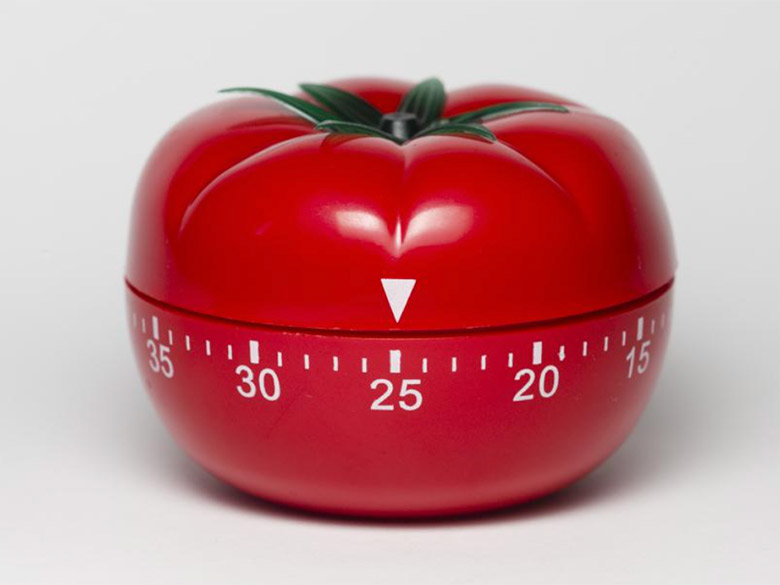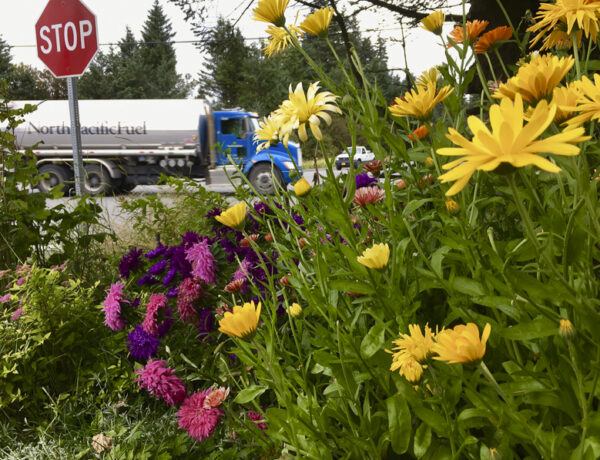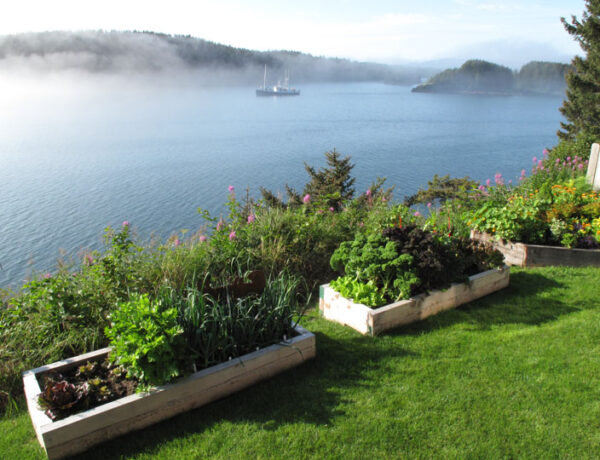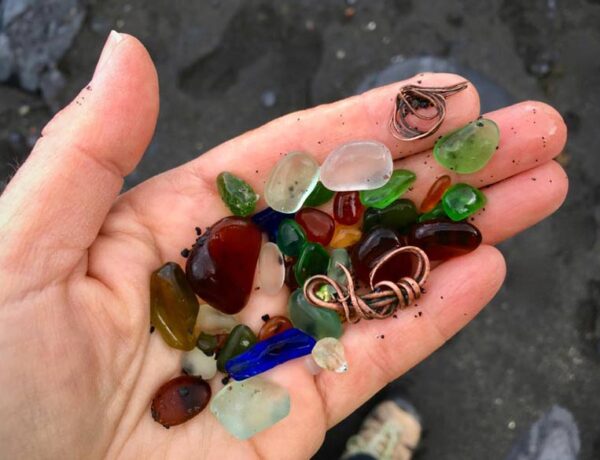Last week’s span of warm, clear days found island gardeners scrambling outside, perched on bended knee pulling weeds, transplanting seedlings, and slaying slugs. It was a flurry of activity that reminded me of a children’s story called, All Summer In a Day, by Ray Bradbury.
The story takes place on Venus where it rains for seven years at a time. And then the rain stops for two hours… and magic happens.
I won’t spoil it for you, but know that it’s worth a read. Trust me and Google it…
In our drive to pack months of planning and dreaming into a few days or hours it’s easy to overdo it, right?
Our backs hurt, tools are lost and re-found, to-do lists get longer, holes appear in gloves, new callouses form, wheelbarrows balk under the weight of compost, we forget time…
Pomodoro to the rescue
The Pomodoro Technique is a time management method developed by Francesco Cirillo in the late 1980s.
It’s popular in office cubicles, but it works just as well in the garden…
I shared the Pomodoro Technique after a student in my Compost Academy complained about time…
[perfectpullquote align=”full” bordertop=”false” cite=”” link=”” color=”” class=”” size=””]”While working in the garden, the hours fly by and before you know it, you’re thirsty, starving, exhausted and your whole day gets away from you.”[/perfectpullquote]
Here’s how pomodoro works:
Use a timer to break down work into intervals, traditionally 25 minutes in length, separated by short breaks. Each interval is known as a pomodoro, from the Italian word for ‘tomato’, after the tomato-shaped kitchen timer that Cirillo used as a university student.
In the garden, I prefer pomodoros of 60 minutes; while working on the computer, 45 minutes.
There are basically six steps in the original pomodoro technique:
- Decide on the task to be done.
- Set the pomodoro timer (25 to 60 minutes)
- Work on the task.
- When the timer rings, stop working.
- Take a short break (about 5 minutes) and then return to work
- After four pomodoros, take a longer break (15–30 minutes).
After you complete a task, using pomodoros, review what you’ve just completed. Do this from a learning point of view:
- What did I learn?
- What could I do better or differently?
It’s important to focus your attention on the task at hand (weeding, planting), while performing a task a la pomodoro. Not to be preachy but if you’re not in the moment, you’ll miss the point and the lesson.
[Hi, it’s Marion here. This article was originally published in the Kodiak Daily Mirror, the hometown newspaper for Kodiak, Alaska. You can access the archive page for my past columns, written each week since 1986].
Moving right along, here are two spring gardening tasks…
…that might be lagging on your list of things to do. Use them to practice your pomodoro skills, rain or shine…
As Mark Twain said:
[perfectpullquote align=”full” bordertop=”false” cite=”” link=”” color=”” class=”” size=””]“In the spring, I have counted 136 different kinds of weather inside of 24 hours.”[/perfectpullquote]
1. Let’s plant potatoes…
One of the easiest things to grow in the whole wide world (besides creepy things in your refrigerator), are potatoes. Before planting them though, do as English gardeners do: Buy some seed potatoes now so you’ve got time to chit them. That’s right, chit them.
Chitting isn’t as weird as it looks and sounds. It’s a great Scrabble word, though even as I type it, Microsoft Word is underlining the word in red.
[perfectpullquote align=”full” bordertop=”false” cite=”” link=”” color=”” class=”” size=””]Chitting simply means setting the potatoes in a well-lit place until they produce shoots about an inch long.[/perfectpullquote]
What is chitting good for?
Chitting helps get potatoes off to a head start before they are planted. A word about choosing which varieties to grow: Don’t bother going to the grocery store, where most potatoes have been treated with a retardant to prevent sprouting.
You’ll want to buy certified seed potatoes that are preferably disease resistant.
This is extremely important.
[perfectpullquote align=”full” bordertop=”false” cite=”” link=”” color=”” class=”” size=””]Ireland’s potato famine of 1845 was caused by a parasitic fungus that killed potato plants. As a result, thousands of people died from starvation.[/perfectpullquote]
Potatoes are in the nightshade family which includes eggplant, peppers, and tomatoes. It’s hard to believe that eggplants and potatoes are related, right?
In the garden, potatoes need plenty of shoulder room, sunshine, and fertile, slightly acid, well-drained soil.
Come planting time, some gardeners look to the heavens for advice, claiming that plants do better if set in the ground during the dark phase of the moon.
The moon is currently in a Waning Gibbous phase, which is the first phase after the full moon occurs. It lasts roughly 7 days with the moon’s illumination or visibility growing smaller each day until it becomes a last quarter “sliver” moon with a visibility of 50 percent.
It’s at this point that potato growers get busy planting spuds…
During the same phase of the moon, it’s a good time to:
2. Sow carrot seeds
[perfectpullquote align=”full” bordertop=”false” cite=”” link=”” color=”” class=”” size=””]Growing carrots is a test of your patience because it can take two to three weeks before they decide to germinate.[/perfectpullquote]
How to get carrot seeds to germinate?
The trick to making sure that carrot seeds sprout is to barely cover them with soil and keep them moist. This means you might have to water the carrot bed more than once a day…
Here’s another technique that my sister-in-law, who lives outside of Anchorage, swears by…
She sows her carrot seeds, covers them with a little soil, and then soaks them with water. Next, she covers them with a piece of carpet.
“It’s a homestead technique,” she says. “It protects them from frost, warms the ground, and you don’t have to water. When the carrots come up, simply remove the carpets.”
And then you wait.
Maybe the pomodoro technique is effective for waiting as well… Reading helps: All Summer In a Day.
I hope you enjoyed this sneak-peek into life on Kodiak Island.
Thanks and I hope your week goes well…

+-+-+-+-+
PS Hey, there… Are you frustrated having to spend so much time pulling weeds? Or watching your plants wither in a drought? After 35 years of gardening, I have learned one thing for sure: Compost is the answer to all your problems. Want to know how to make compost in 6 short weeks? (now THAT is a tongue-twister!)? Join the waitlist for my next FREE composting webinar. And you might enjoy my Joy of Composting Facebook page. If you’d like to drop me a note, here’s my email address: marion (at) marionowenalaska.com.





No Comments